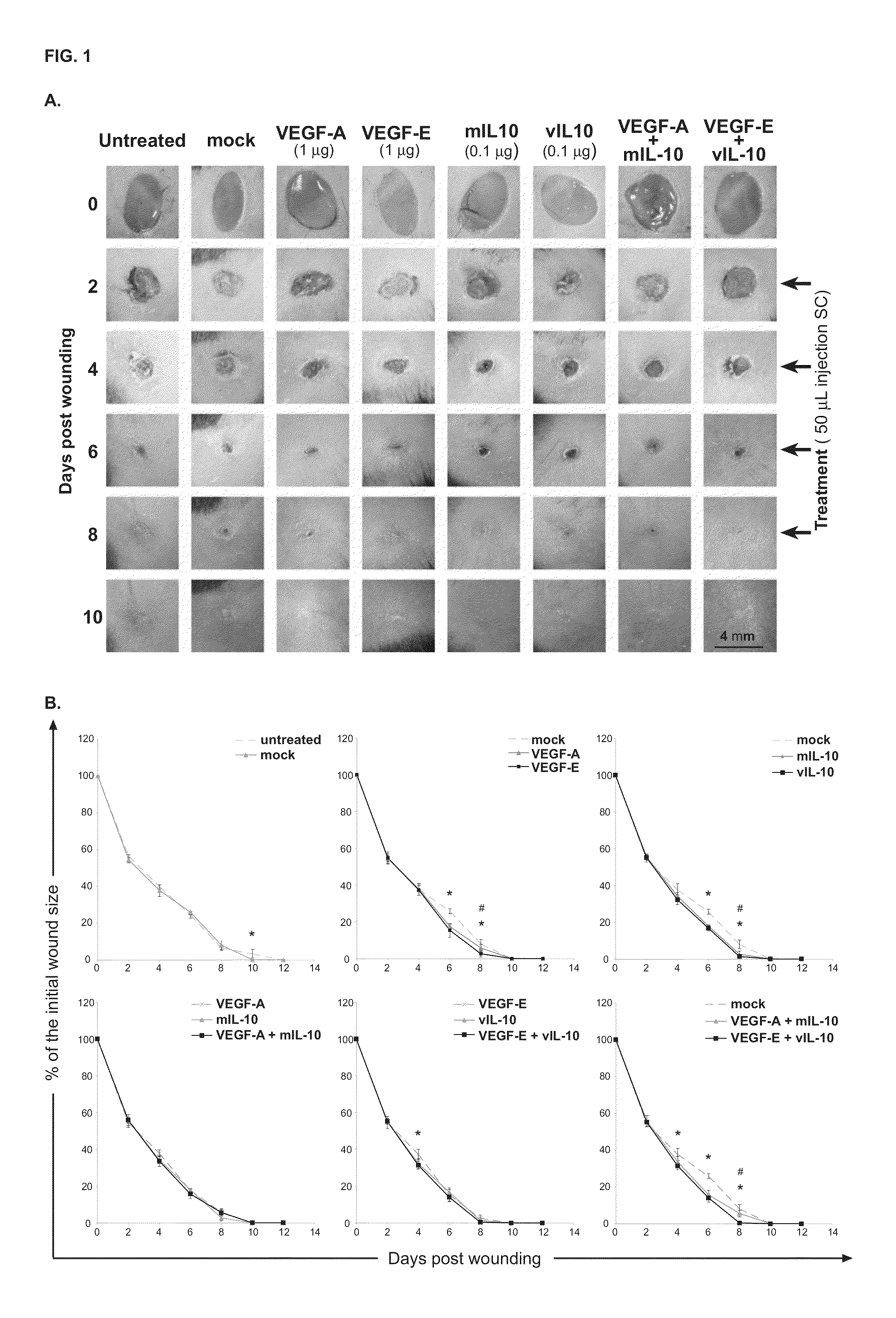Combination treatments and compositions for wound healing comprising viral VEGF
a technology of conjugation treatments and compositions, applied in dermatological disorders, peptide/protein ingredients, cardiovascular disorders, etc., can solve the problems of chronic wounds, ulcers, and ulcers that do not heal at normal or expected rates, and increase the economic burden of healthcare services, so as to reduce scarring and scar quality, the effect of fewer administration time points
- Summary
- Abstract
- Description
- Claims
- Application Information
AI Technical Summary
Benefits of technology
Problems solved by technology
Method used
Image
Examples
example 1
Preparation of Therapeutic Proteins and Experimental Procedures
Recombinant Proteins
[0263]Recombinant FLAG-tagged VEGF-A and VEGF-E (ORFVNZ2VEGF), and murine (m) IL-10 and orf virus IL-10 (vIL-10) were expressed in 293-EBNA cells, purified and quantitated as previously described (Wise et. al., J Biol Chem 278, 38004-38014, 2003, Imlach et. al., J Gen Virol 83, 1049-1058, 2002).
Mice
[0264]Specific Pathogen Free female C57BL / 6 mice (6-8 weeks of age) were obtained from the University of Otago Animal Facility and were used with institutional ethical approval.
[0265]On day 0, mice were anesthetized by subcutaneous (SC) injection of ketamine / domitor / atropine (75 / 1 / 0.05 mg / kg body weight, respectively), the dorsum shaved, depilated with Veet cream (Reckitt Benckiser) and cleaned with saline. Two full-thickness excisional wounds were made on each animal, one on each flank, using a sterile, disposable, 4-mm-diameter biopsy punch (Kruuse). Mice were given SC injections of Bup...
example 2
Treatment with Viral VEGF and Viral IL-10 Accelerates Wound Closure
[0276]Treatment with a combination of viral VEGF-E and viral IL-10 accelerates wound closure to a greater extent than the individual treatments or their mammalian equivalents.
[0277]The ability of the viral factors to regulate tissue repair in a mouse model of cutaneous wound healing was examined in this Example. Excisional wounds were treated on days 2, 4, 6 and 8 by subcutaneous (SC) injection of equal doses of the viral or mammalian VEGFs, or IL-10s, alone or in combination and were compared to untreated or mock-treated wounds.
[0278]Photographs taken at the indicated time points during wound healing and measurement in wound size revealed differences in healing kinetics and the time to wound closure between the treatment groups (FIG. 1). Mock treatment of wounds with SC injection of PBS induced a significant reduction in wound size at day 8 compared to untreated wounds but this did not translate to a significant inc...
example 3
Treatment with Viral VEGF and Viral IL-10 Enhances Epidermal Regeneration
[0284]Treatment with the combination of VEGF and IL-10 enhances epidermal regeneration over that of treatment with the factors alone.
[0285]This Example was carried out to determine if the accelerated wound closure observed in wounds treated with the viral factors was due to enhanced re-epithelialization. On various days post wounding, the skin surrounding each wound was excised and the neo-epidermis was analyzed histologically or by quantitative RT-PCR.
[0286]The direct effect of a single treatment of viral or mammalian VEGFs, or IL-10s, alone or in combination, on the wound neo-epidermis was investigated by MSB trichrome staining of sections from treated and untreated wounds after 3, 6 and 9 days. Representative sections shown in FIG. 3A illustrate that VEGF-E and VEGF-A treatment increased wound re-epithelialization compared with the control wounds. Re-epithelialization was then quantitated by determining the ...
PUM
| Property | Measurement | Unit |
|---|---|---|
| thickness | aaaaa | aaaaa |
| capillary return time | aaaaa | aaaaa |
| volumes | aaaaa | aaaaa |
Abstract
Description
Claims
Application Information
 Login to View More
Login to View More - R&D
- Intellectual Property
- Life Sciences
- Materials
- Tech Scout
- Unparalleled Data Quality
- Higher Quality Content
- 60% Fewer Hallucinations
Browse by: Latest US Patents, China's latest patents, Technical Efficacy Thesaurus, Application Domain, Technology Topic, Popular Technical Reports.
© 2025 PatSnap. All rights reserved.Legal|Privacy policy|Modern Slavery Act Transparency Statement|Sitemap|About US| Contact US: help@patsnap.com



